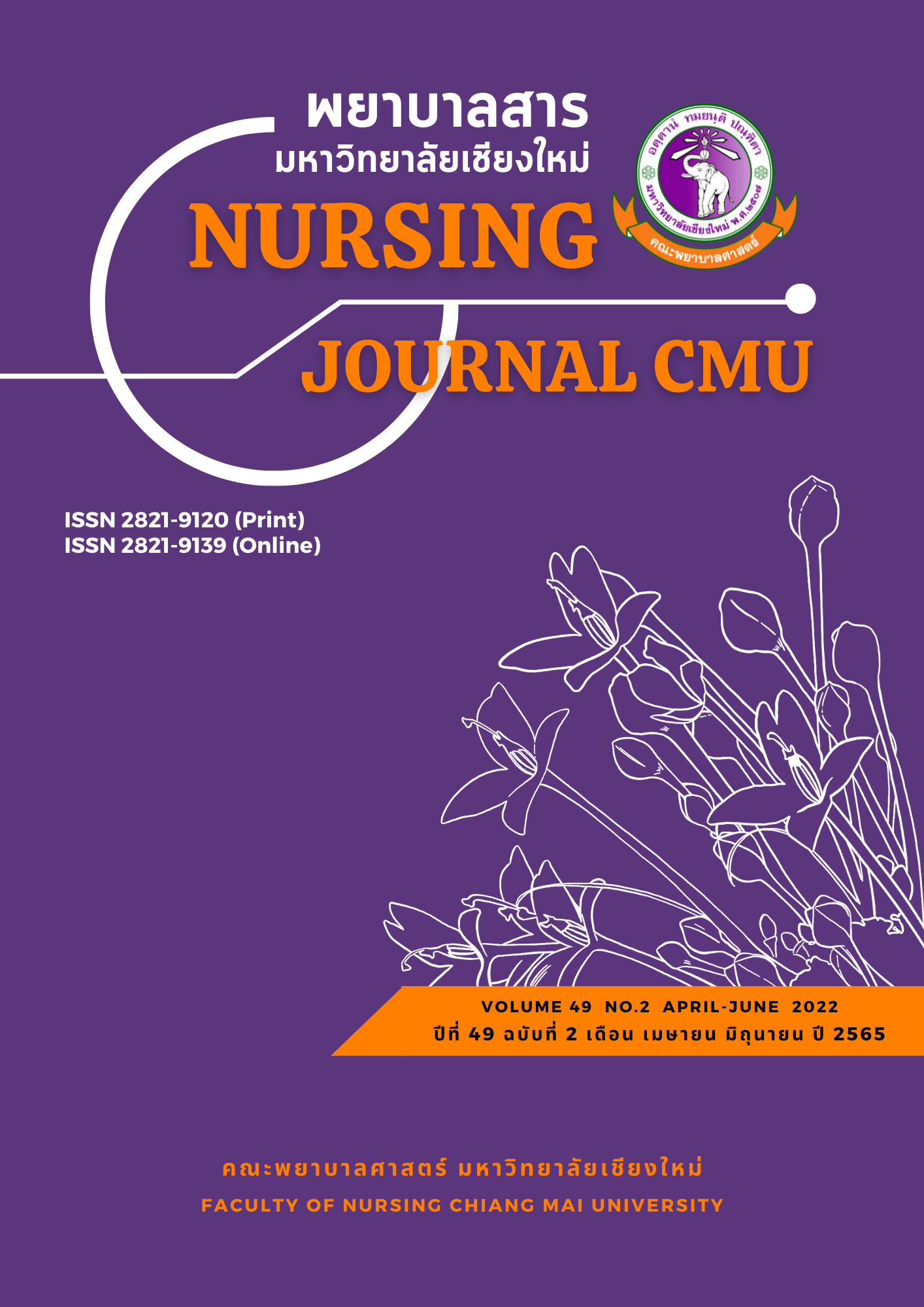The Effects of a Self-efficacy Perception-promoting Program for Nursing Students on Knowledge about Tobacco and Self-efficacy to Promote Smoking Cessation
Keywords:
Perception of self-efficacy, Knowledge about tobacco, Smoking cessation, Online programAbstract
This experimental study aimed to test the effects of self-efficacy promotion for nursing students on knowledge about tobacco and self-efficacy regarding smoking cessation. The sample of this study were second-year students from the Faculty of Nursing, Mahasarakham University, who were randomly assigned to a control or experimental group with 30 in each group. The experimental group received the self-efficacy promoting program using Google classroom and Google meet over a 6-week period, and the control group received a normal program of study arranged by the Faculty of Nursing. Instruments for collecting data included 1) the Tobacco Knowledge Testing Form, and 2) the Perception of Self-Efficacy to Promote Smoking Cessation Questionnaire which had reliability of .70 and .91, respectively. Data were analyzed using descriptive statistics and a t-test.
The results of the study showed that, after intervention, the experimental group had statistically significantly higher mean scores of knowledge about tobacco and perception of self-efficacy to promote smoking cessation than before the intervention, and higher than those of the control group (p < .05).
According to these study results, nursing institutions should use this program for increasing knowledge and perceptions of self-efficacy of students so that students can apply their knowledge and skills to motivate their clients to quit tobacco in the future.
References
Bandura, A. (1997). Self-efficacy: The exercise of control. New York: W. H. Freeman and Company.
Center of Disease Control and Prevention. (2020). Youth and Tobacco Use Retrieved from https://www.cdc.gov/tobacco/data_statistics/fact_sheets/youth_data/ tobacco_use/index.htm
Chaiyalap, S., Vongareesawat, V., & Riyaphan, S. (2018). Professional experience promoting activities for enhancing knowledge, attitude and practice skills against harmfulness of tobacco among nursing students. Thai Journal of Nursing, 67(1), 33-39. (in Thai)
Chaiyasung, P., Tana, P., Sridet, R., & Wises, N. (2020). The efficiency of potential development on knowledge and counselling skills on smoking cessation via online in educational institution among nursing student leaders. Thai Journal of Nursing, 69(1), 36-43. (In Thai)
Cohen, J. (1988). Statistical power analysis for the behavioral sciences (2nd ed.). Hillsdale, NJ: Lawrence erlbaum associates.
Crippa, G.; Bergonzi, M.; Bravi, E.; Balordi, V.; Cassi, A. (2018). Effect of electronic on blood pressure in hypertension patients: Evaluation by non-invasive continuous ambulatory blood pressure measurement. Journal of Hypertension, 36(e-Supplement 1), e4. doi: 10.1097/01.hjh. 0000538974. 96760.a3
Damkliang. J., Kritpracha, C. Prasartwanakit, A. & Chinnawong, T. (2018). Nursing students’ experiences of using the 5A’s model for tobacco control among adult and elderly patients. Songklanagarind. Journal of Nursing, 38 (3), 141-151.
Hongtiyanon, T., Tipawong, A., Yodkolkij, L., & Chaleoykitti, S. (2019). The effectiveness of perceived self-efficacy program for assisting adolescences towards behavioral of avoiding narcotics. Royal Thai Army Medical Journal, 72(1), 33-40. (In Thai)
Junnual, N. & Wilasri, S. (2017). The application of Self-Efficacy Theory in achieving smoking behavior change among police officers at chaiyaphum police station. The Journal of Baromarajonani College of Nusing, Nakhonratchasima, 23(1), 44-58. (In Thai)
National Statistical Office. (2018). The smoking and drinking behavior survey 2017. Bangkok: Pimdeekarnpim Co., Ltd.
Pimroon, S. Pungbangkadee, R., Jewpattanakul, Y., & Chuetaleng, T. (2021).Factors influencing tobacco control practice among the registered nurses who used to attending as a leader of the nursing student smoke-free Thai society club. Journal of The Royal Thai Army Nurses, 22(1), 216-225. (In Thai)
Raksatham, S., Nirotnun, U., & Tirapaiwong, Y. (2019). The current situation of teaching for health promoting smoking prevention and smoking cessation of nursing students at boromarajonani college of nursing, bangkok. Journal of Health and Nursing Research, 35(2) 71-812.
Sanee, A., Pantaewan, P., & Boonrubpayap, B. (2013). A potential developing program for nurse student leaders on knowledge, attitude toward tobacco, and smoke cessation counseling skills in community. Nursing science Journal, 62(1), 22-31. (In Thai)
Tobacco Control Research and Knowledge Management Center. (2020). Tobacco consumption: Thailand report, 2021. Retrieved form https://www.trc.or.th/th/media/attachments/2020/07/19/..-2562.pdf
Waehayee, H., Chaichana, B., & Ruangdej, K. (2013). Effectiveness of a life skill training program on perceived self-efficacy for the prevention of smoking among the first year students at yala rajabhat university. Nursing Journal of the Ministry of Public Health, 22(1), 85-131.
World Health Organization. (2014). Toolkit for delivering the 5A’s and 5R’s brief tobacco interventions. Geneva: WHO Press.
World Health Organization. (2019). WHO report on the global tobacco epidemic 2019: Offer help to quit tobacco use. Retrieved from https://www.who.int/ publications/i/item/9789241516204
World Health Organization. (2021). WHO report on the global tobacco epidemic 2021: addressing new and emerging products. Retrieved form https://www.who.int/teams/health-promotion/tobacco-control/global-tobacco-report-2021
Downloads
Published
How to Cite
Issue
Section
License
Copyright (c) 2022 Nursing Journal

This work is licensed under a Creative Commons Attribution-NonCommercial-NoDerivatives 4.0 International License.
บทความที่ได้รับการตีพิมพ์เป็นลิขสิทธิ์ของวารสารพยาบาลสาร
ข้อความที่ปรากฏในบทความแต่ละเรื่องในวารสารวิชาการเล่มนี้เป็นความคิดเห็นส่วนตัวของผู้เขียนแต่ละท่านไม่เกี่ยวข้องกับมหาวิทยาลัยเชียงใหม่ และคณาจารย์ท่านอื่นๆในมหาวิทยาลัยฯ แต่อย่างใด ความรับผิดชอบองค์ประกอบทั้งหมดของบทความแต่ละเรื่องเป็นของผู้เขียนแต่ละท่าน หากมีความผิดพลาดใด ๆ ผู้เขียนแต่ละท่านจะรับผิดชอบบทความของตนเองแต่ผู้เดียว






